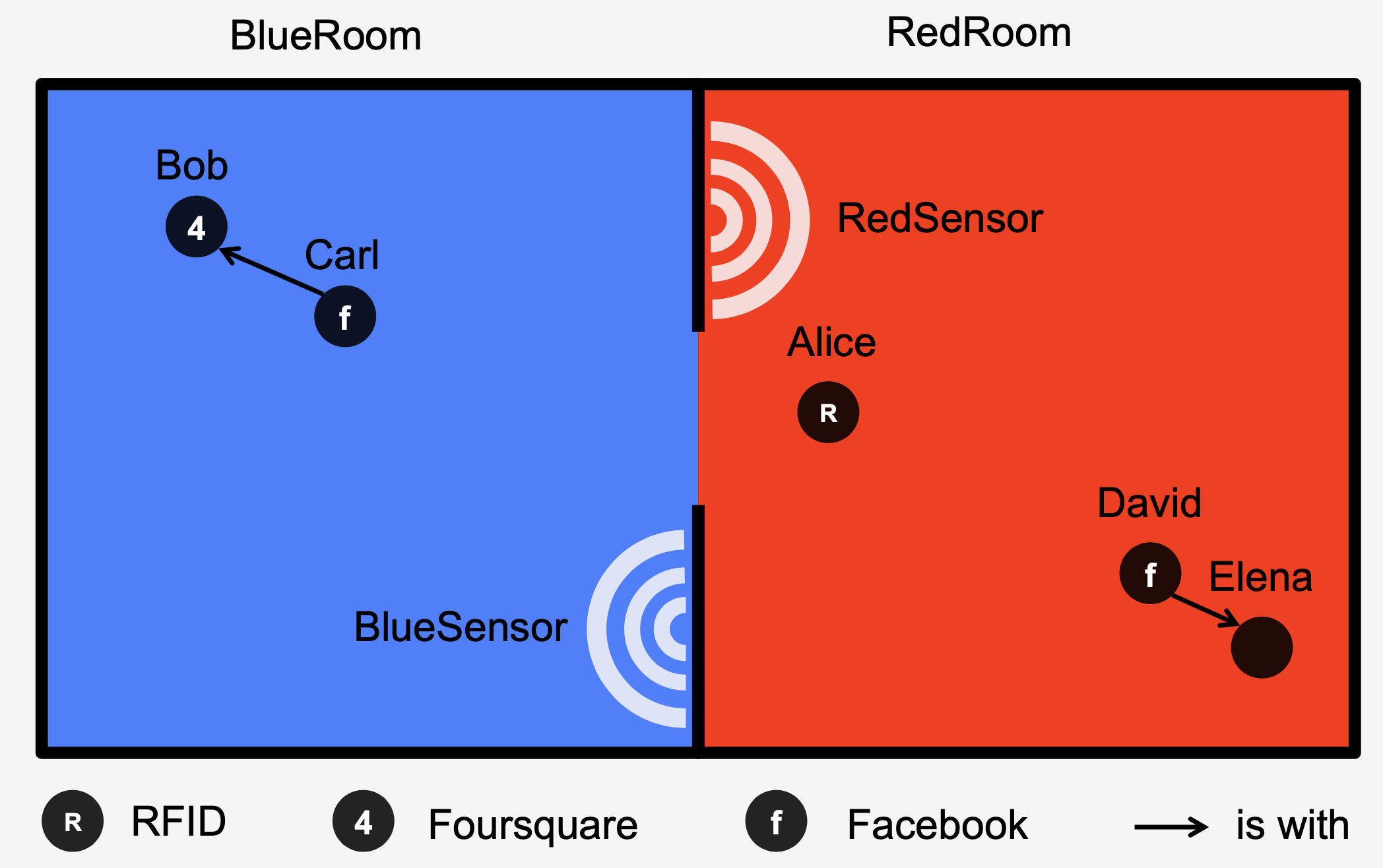Stream Reasoning Architecture (Overview)
Stream Resoning technology is a system that uses multiple, heterogeneous, huge, and necessarily noisy streams of data in real time to make sense of the data in order to support the decision-making process of a very large number of simultaneous users.
A basic example of how the system works is shown below: there are two rooms (red-room and blue-room), and (1) Alice is sensed by Sensortag to be in the red room at time T1 (Sensor:Redsensor, Room:RedRoom, Person:Alice Room:RedRoom, Person:Alice, Time-stamp:T1), (2) Sensor detects that Bob enters the Blue Room at time T2 (Person:Bob, ChecksIn:BlueRoom, Time-stamp:T2), and (3) Facebook records that Carl is with Bob at time T2 (Person:Carl). (Person:Carl, With:Bob, Time-stamp:T2), and David is also in the RedRoom with Elena at time T3 (Person:David, IsIn:RedRoom, WIth:Elena, Time-stamp:T3).
A diagram of the above situation is shown below.

In such a situation, for example, “Who is in the same room as Alice right now? or “How long has the person in the room next to Alice been there? The Stream Reasoning system is characterized by its ability to provide answers to flexible questions such as “Who is in the same room as Alice right now?
The difference between this system and the conventional DSMS/CEP system is the flexibility of the query. For example, there are three sources of information here: sensor tags, sensors that look at check-ins, and Facebook. In a conventional DSMS/CEP system, if the schema of each sensor is fixed, it is possible to get an answer to a fixed (fixed) query. However, in the real world, there are many variations in the situations/contexts that need to be addressed, and it is necessary to use data in a way that is tailored to each situation on a case-by-case basis.
These issues are also related to the problem of IOT technology not being viable as a business, as it is difficult to balance the cost of installing IOT with the benefits to be gained when trying to use IOT only for certain purposes.
Stream Reasoning technology addresses this issue by flexibly combining various sensor data or available data (e.g., social networking sites) and using semantic web technologies such as ontologies to respond to queries in various contexts. It is a technology that can respond to various context-specific queries using semantic web technologies such as ontology.
There are currently no commercially available systems for stream-resonance technology, and the following systems have been reported.
| 名前 | 出典 |
| Streaming SPARQL |
AndreBolles,MarcoGrawunder,JonasJacobi:Streaming SPARQL – Extending SPARQL to Process Data Streams. ESWC 2008: 448-462
|
| C-SPARQL |
DavideFrancescoBarbieri,DanieleBraga,StefanoCeri, Emanuele Della Valle, Michael Grossniklaus: Querying RDF streams with C-SPARQL. SIGMOD Record 39(1): 20-26 (2010)
|
| CQELS |
DanhLePhuoc,MinhDao-Tran,JosianeXavierParreira,Manfred Hauswirth: A Native and Adaptive Approach for Unified Processing of Linked Streams and Linked Data. International Semantic Web Conference (1) 2011: 370-388
|
| INSTANS |
Rinne,M.,Nuutila,E.,Törma,S.:
INSTANS: High-Performance Event Processing with Standard RDF and SPARQL. Poster in ISWC2012 |
| Streaming Linked Data |
MarcoBalduini,EmanueleDellaValle,DanieleDell’Aglio,Mikalai Tsytsarau, Themis Palpanas, Cristian Confalonieri: Social listening of City Scale Events using the Streaming Linked Data Framework. ISWC 2013
|
| TEF-SPARQL |
ShenGao,ThomasScharrenbach,AbrahamBernstein:The CLOCK Data-Aware Eviction Approach: Towards Processing Linked Data Streams with Limited Resources. ESWC 2014: 6-20
|
| Streaming Knowledge Base |
Walavalkar,O.,Joshi,A.,Finin,T.,Yesha,Y.,2008.Streaming knowl- edge bases. In: In International Workshop on Scalable Semantic Web Knowledge Base Systems
|
| IMaRS |
DavideFrancescoBarbieri,DanieleBraga,StefanoCeri, Emanuele Della Valle, Michael Grossniklaus: Incremental Reasoning on Streams and Rich Background Knowledge. ESWC (1) 2010: 1-15
|
| TrOWL |
YuanRen,JeffZ.Pan:Optimisingontologystreamreasoning with truth maintenance system. CIKM 2011: 831-836
|
| ETALIS |
DarkoAnicic,PaulFodor,SebastianRudolph,NenadStojanovic: EP-SPARQL: a unified language for event processing and stream reasoning. WWW 2011: 635-644
|
| sparkwave |
Srdjan Komazec, Davide Cerri, Dieter Fensel: Sparkwave: continuous schema-enhanced pattern matching over RDF data streams. DEBS 2012: 58-68
|
| SR based on Answer Set Programming |
Martin Gebser, Torsten Grote, Roland Kaminski, Philipp Obermeier, Orkunt Sabuncu, Torsten Schaub: Stream Reasoning with Answer Set Programming: Preliminary Report. KR 2012
|
| parallerising Stream Reasoning |
Jacopo Urbani, Alessandro Margara, Ceriel J. H. Jacobs, Frank van Harmelen, Henri E. Bal: DynamiTE: Parallel Materialization of Dynamic RDF Data. International Semantic Web Conference (1) 2013: 657-672
|
| STARQL |
ÖL Özçep, R Möller, C Neuenstadt, “A Stream-Temporal Query Language for Ontology Based Data Access”. Description Logics, 2014
|
There are three main basic configurations.

Data-Driven type (frontward reasoning)

Query-Driven type (query rewriting)

Query-Driven Type (backward reasoning)
In the next article, we will introduce the specifics of individual Stream Reasoning.


コメント